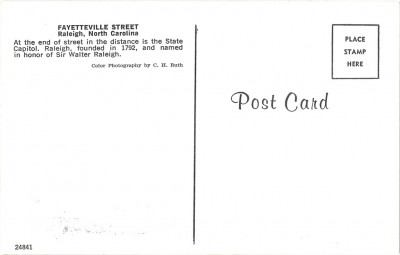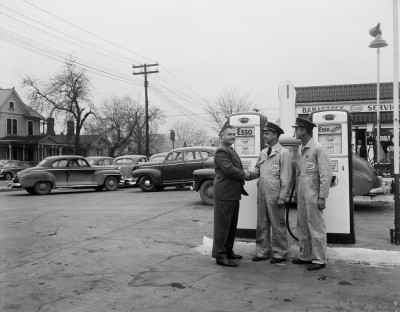Fayetteville Street, Raleigh, North Carolina
A couple weeks ago Flashback Friday took a look at a 1915 viewcard of Fayetteville Street, looking south from the north end. This week we take another look, this time from the south looking north, 50 years hence — with a revealing twist.
Fayetteville Street, Raleigh, North Carolina. At the end of the street in the distance is the State Capitol. Raleigh, founded in 1792, and named in honor of Sir Walter Raleigh.
No message this week.Â
The Horse and Buggy Era Collides with Carzilla
Well into the first two decades of the 20th century, most Raleigh residents continued to get around town by horse and buggy, electric streetcar or their own foot power. Readers may have noticed that many of our featured postcards from this period show pedestrians, streetcars and horse-powered conveyances traversing the city’s streets.
Fayetteville Street, looking north, ca 1907.
Automobiles first appeared on Raleigh’s streets about the time of the postcard view depicted above, but for many years only the well-to-do could afford them. Although Henry Ford’s ‘people’s car’ — the Model T — had been introduced nationally in 1908, it wasn’t until 1914 that sales of the ‘any color as long as it’s black’ model really took off. In Raleigh, by the end of WW I the automobile was beginning to replace the horse as the favored mode of transportation by the city’s middle class.
As a result of the rise in the popularity of the automobile, the city of Raleigh began paving over its Belgian block and dirt streets with smoother asphalt and macadam surfaces.
And what product fuels cars? Why, gasoline, of course!
Initially, gasoline was sold from the automobile garages that had begun to replace livery stables throughout the city. By 1920, independent filling stations were popping up on street corners all over downtown Raleigh.
The photo below was taken in 1916 from the intersection of Fayetteville and Cabarrus Streets. On the corner, on the left, is a typical 19th century Raleigh residence, which at that time was being run as a boarding house by Mrs. Julia Dinkins. The lower end of Fayetteville St. in those days was still primarily residential.
Fayetteville St., looking north from Cabarrus St. about 1916. Note the asphalt pavement, the streetcar tracks, and the single automobile parked at the curb.
The view above is precisely that of the view in this week’s postcard.
By 1922, Mrs. Dinkins’ boarding house had been demolished and replaced by the Central Filling Station — one of Raleigh’s first. Over the following two decades various gas stations occupied that lot on the corner. Finally, in 1940, Henry Barnette opened Barnette’s Esso Service there.
Mr. Barnette greets station attendants at his Esso station in 1947.Â
Barnette’s still occupied the corner of Fayetteville and Cabarrus Streets when the photo on this week’s postcard was taken in 1964. Today, this block of Fayetteville St. is known as City Plaza.
There is no indication of a publisher on our Flashback Friday photochrome postcard this week. The photo is credited, however: “Color Photography by C.H. Ruth”
“Flashback Friday†is a weekly feature of Goodnight, Raleigh! in which we showcase vintage postcards depicting our historic capital city. We hope you enjoy this week end treat!
Â






 Sign up for the Newsletter
Sign up for the Newsletter
06/06/2014
Thanks guys!
06/08/2014
One of my family’s favorite postcards!
My Dad had an arrangement to park his car every day at Barnette’s Esso station. That’s his black ’59 Thunderbird parked under the Esso sign, and his office building (BB&T) on the right.